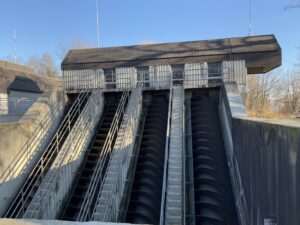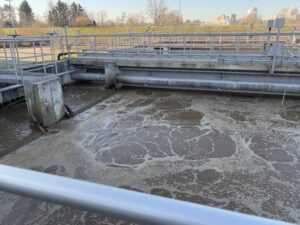This field trip STINKS!
On Wednesday, the 5th of March, as a class we took a field trip to the wastewater treatment plant in Bonn-Beuel. The plant we went to, the Kläranlagen Beuel, purifies the wastewater from 80,000 homes in the Bonn area. In a typical day the plant processes 9.7 million liters of wastewater and has a maximum capacity of 41.4 million liters a day. This allows the plant to be able to handle way more wastewater than what’s produced in peak flow.

As a part of our class we have been learning about critical infrastructure found in every city, including how wastewater is processed. One thing that we learned both in class and on a previous excursion to a rainwater collection agency in Berlin is that during times of rain, wastewater processing plants can be overwhelmed by the extra water coming into the sewage systems. The plant in Beuel’s solution to this problem is that it has a rain retention basin and two rain overflow basins to collect excess rainwater and process it when the weather is dry, spreading out the load over a longer period of time.

The water treatment process begins with mechanically cleaning the water, removing any solids easily filtered out of the water such as toilet paper. Then the wastewater is digested by microorganisms to continue filtering out impurities, finally sludge is removed from the waste water producing clean water. As you can imagine all of these processes make the whole plant smell pretty bad, however by the end this water is clean enough that there is a population of carp living in a pond filled with this water, this water is then pumped into the Rhein, of which I visited the outlet on my own on Friday. This freshwater, while technically clean enough to drink, can not be used as drinking water as per German law declaring it as a disgusting source, however the Rhein is not considered a disgusting source and is the source of drinking water for much of the area. Ultimately, this means that the water is indirectly recycled into drinking water.
-Andy
Kläranlagen. Bundesstadt Bonn. (2024, December 20). https://www.bonn.de/themen-entdecken/umwelt-natur/klaeranlagen.php

Golly Gee! That sounds really interesting. I bet it smelled real funky up in there, but not as bad as my apartment which reeks of boiled cabbage.
-Godspeed
Winston Smith